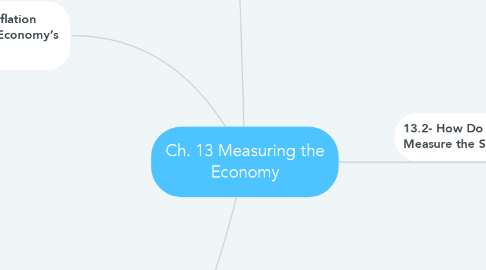
1. 13.2- How Do Economists Measure the Size of an Economy?
1.1. 1. Calculating GDP (gross domestic product) Economists typically calculate GDP by measuring expenditures on goods and services produced in a country
1.1.1. Final Good: Any new good that is ready for consumer use; final goods are included in the calculation of GDP
1.2. 2. Adjusting the GDP for inflation Economists use GDP figures to determine not only how big an economy is, but whether it is growing or shrinking and at what rate
1.2.1. Market Value: The price buyers are willing to pay for a good or service in a competitive market
1.3. 3. Adjusting the GDP for population Economists also use GDP to compare the economies of individual countries. To make accurate comparisons, economists must adjust GDP.
1.3.1. Intermediate Goods: A good used in the production of a final good; intermediate goods are not included in the calculation of GDP
1.4. 4. Limiting the GDP to serve as an indicator of economic health. Gross domestic product is a useful tool for measuring economic growth. But as a measure of the overall health of an economy, GDP has several limitations, like not accounting for illegal trades
1.4.1. Net Exports: The value of all exports minus all imports
2. 13.3- What Does the Unemployment Rate Tell Us About an Economy’s Health?
2.1. 1. How the government measures unemployment. Every month, the BLS reports the total number of people who were unemployed for the previous month
2.1.1. Unemployment Rate: the percentage of the labor force that is not employed but is actively seeking work
2.2. 2. The different types of unemployment. There are many different forms, like: Frictional, structural, seasonal, and cyclical.
2.2.1. Frictional Employment: a type of unemployment that results when workers are seeking their first job or have left one job and are seeking another
2.3. 3. Problems with the Unemployment Rate as an Indicator of Economic Health. In determining how many of the country's more than 315 million people are unemployed, the BLS makes every effort to be accurate.
2.3.1. Structural Employment: a type of unemployment that results when the demand for certain skills declines, often because of changes in technology or increased foreign competition; under such conditions, workers may need retraining to find new jobs
2.4. 4. The Economic Costs of High Unemployment. Despite its flaws, the official unemployment rate serves as a fairly good indicator of conditions in the labor market. And in general, when the rate is high, the overall health of the economy is poor.
2.4.1. Seasonal Employment: a type of unemployment that results when businesses shut down or slow down for part of the year, often because of weather
3. 13.4- What Does the Inflation Rate Reveal About an Economy’s Health?
3.1. 1. Tracking Inflation with the Consumer Price Index. The BLS tracks inflation by gathering information on Americans' cost of living. That is, it studies the cost of buying the goods and services that households like yours purchase every day.
3.2. 2. Creeping Inflation, Hyperinflation, and Deflation
3.2.1. Creeping Inflation: a gradual, steady rise in the price of goods and services over time
3.2.2. Deflation: a fall in the price of goods and services; the opposite of inflation

